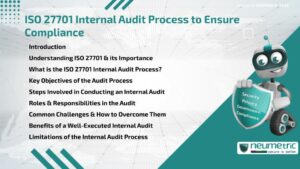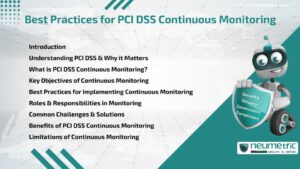Table of Contents
ToggleIntroduction
The PCI DSS Continuous Monitoring process is a vital approach for protecting payment card data & maintaining Compliance with the Payment Card Industry Data Security Standard [PCI DSS]. By continuously reviewing Security Controls, detecting Anomalies & addressing Risks in real time, Organisations reduce the Likelihood of Data Breaches. This Monitoring ensures that businesses do not simply achieve Compliance once a year but instead maintain Security every day. Through Best Practices, clear responsibilities & effective tools, Organisations can strengthen Trust & Resilience against evolving Cyber Threats.
Understanding PCI DSS & Why it Matters
PCI DSS is a global security Standard developed to protect Cardholder Data. It applies to all entities that store, process or transmit payment card information. Compliance is mandatory for Merchants, Service Providers & Financial institutions.
The Framework outlines twelve (12) key requirements, including strong Access Controls, Network Monitoring & Vulnerability Management. While Compliance may be assessed annually, Security Risks exist daily. This makes PCI DSS Continuous Monitoring crucial for long-term protection.
What is PCI DSS Continuous Monitoring?
PCI DSS Continuous Monitoring involves ongoing evaluation of systems, networks & processes to ensure Compliance is maintained. It focuses on real-time detection of Vulnerabilities, Misconfigurations & Unauthorised Access.
Instead of one-time checks, Continuous Monitoring provides ongoing assurance that Cardholder Data is protected. This approach includes Automated tools, regular Log Reviews & prompt Corrective Actions.
Key Objectives of Continuous Monitoring
The objectives of PCI DSS Continuous Monitoring include:
- Maintaining Compliance between formal Audits
- Detecting & Responding to Threats in real time
- Ensuring Controls are functioning as intended
- Reducing Risk of Breaches & Financial penalties
- Building ongoing Trust with Customers & Partners
By setting these objectives, Organisations ensure their monitoring efforts remain aligned with Compliance & Business Goals.
Best Practices for Implementing Continuous Monitoring
To effectively implement PCI DSS Continuous Monitoring, Organisations can adopt the following Best Practices:
- Automate Security Monitoring – Use tools for Log collection, Intrusion detection & Vulnerability scanning.
- Regularly review logs – Daily or weekly log reviews help identify suspicious activity early.
- Integrate monitoring with Incident Response – Ensure detected issues trigger timely investigations & resolutions.
- Monitor privileged accounts – Pay close attention to accounts with elevated access rights.
- Apply Patch Management consistently – Continuously monitor & update systems to reduce Vulnerabilities.
- Segment networks effectively – Limit Cardholder Data environments & continuously validate segmentation controls.
- Document findings – Keep Records of monitoring activities to demonstrate Compliance during Audits.
Roles & Responsibilities in Monitoring
PCI DSS Continuous Monitoring requires coordination across departments. Security teams configure & maintain Monitoring Tools, while Compliance officers ensure Documentation & Reporting. Its staff support system updates & management provides oversight.
Each group plays a critical role in ensuring Security Controls remain effective & aligned with PCI DSS requirements.
Common Challenges & Solutions
Organisations may face difficulties such as:
- Alert fatigue – Too many notifications can overwhelm teams.
Solution: Fine-tune Monitoring Tools to reduce noise. - Limited resources – Smaller businesses may struggle to maintain full-time monitoring.
Solution: Use Managed Security Service Providers [MSSPs]. - Integration issues – Diverse systems may not communicate well.
Solution: Implement centralised monitoring platforms.
Benefits of PCI DSS Continuous Monitoring
Effective PCI DSS Continuous Monitoring provides several benefits:
- Stronger protection for Cardholder Data
- Reduced Risk of Data Breaches & Penalties
- Early detection of suspicious activity
- Improved Audit readiness
- Greater Customer & Partner confidence
These advantages make Continuous Monitoring not just a Compliance requirement but a strategic investment.
Limitations of Continuous Monitoring
While highly effective, PCI DSS Continuous Monitoring has limitations. It requires skilled staff & can be resource-intensive. Monitoring Tools may also generate false positives, leading to wasted effort.
Additionally, Continuous Monitoring cannot prevent all Risks; it must be paired with robust Security Controls, regular Assessments & an effective Response Plan.
Takeaways
- Provides daily assurance of PCI DSS Compliance
- Detects & addresses Threats in real time
- Strengthens Cardholder Data Protection
- Improves readiness for external Audits
- Builds Customer Trust & Confidence
FAQ
What is the main purpose of PCI DSS Continuous Monitoring?
Its main purpose is to protect Cardholder Data by ensuring Security Controls are effective at all times.
How often should PCI DSS Continuous Monitoring be performed?
It is a continuous, ongoing process with daily, weekly & monthly review cycles.
What tools are used in PCI DSS Continuous Monitoring?
Tools include Intrusion Detection Systems, Vulnerability scanners, Log Management solutions & Security Information & Event Management [SIEM] systems.
Who is responsible for PCI DSS Continuous Monitoring?
Security teams, Compliance officers, IT staff & Management all share responsibility.
Does PCI DSS Continuous Monitoring replace annual audits?
No, it complements annual Audits by maintaining Compliance between them.
Can Small Businesses implement PCI DSS Continuous Monitoring?
Yes, Small Businesses can use cloud-based or outsourced solutions to meet monitoring requirements.
What are common findings during PCI DSS Continuous Monitoring?
Findings often include Unpatched Systems, Misconfigured Access Controls & Suspicious Login attempts.
Need help for Security, Privacy, Governance & VAPT?
Neumetric provides organisations the necessary help to achieve their Cybersecurity, Compliance, Governance, Privacy, Certifications & Pentesting needs.
Organisations & Businesses, specifically those which provide SaaS & AI Solutions in the Fintech, BFSI & other regulated sectors, usually need a Cybersecurity Partner for meeting & maintaining the ongoing Security & Privacy needs & requirements of their Enterprise Clients & Privacy conscious Customers.
SOC 2, ISO 27001, ISO 42001, NIST, HIPAA, HECVAT, EU GDPR are some of the Frameworks that are served by Fusion – a SaaS, multimodular, multitenant, centralised, automated, Cybersecurity & Compliance Management system.
Neumetric also provides Expert Services for technical security which covers VAPT for Web Applications, APIs, iOS & Android Mobile Apps, Security Testing for AWS & other Cloud Environments & Cloud Infrastructure & other similar scopes.
Reach out to us by Email or filling out the Contact Form…





